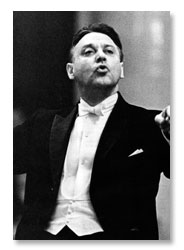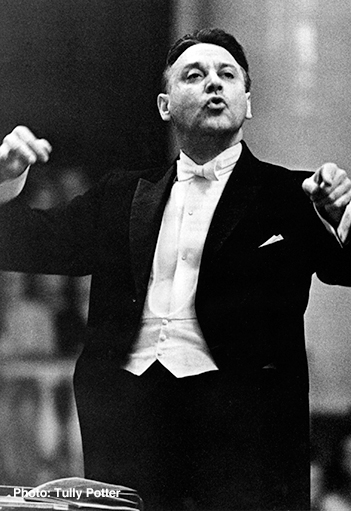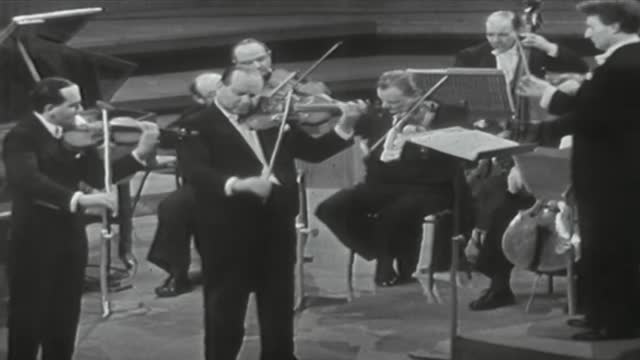

Kirill Kondrashin was born into a musical family: both his parents were string players, with Koussevitzky’s orchestra and then that of the Bolshoi Theatre in Moscow. He took piano lessons from the age of six, studied music theory with Nikolay Zhilyayev and went on to study conducting from 1932 to 1936 at the Moscow Conservatory, where he was a pupil of Boris Khaikin. Having already made his conducting debut at the Moscow Children’s Theatre in 1931, Kondrashin worked as assistant conductor at the Stanislavsky and Nemirovich-Danchenko Musical Theatre from 1934, making his debut there with the French operetta Les Cloches de Corneville by Planquette. When Khaikin was appointed chief conductor at the Maly Theatre in Leningrad, Kondrashin followed him and conducted there from 1936 to 1943; his repertoire was extensive and included Puccini’s La fanciulla del West as well as contemporary works such as Pashchenko’s Pompadour. He was awarded a diploma in 1938 at the First All-Union Conductors’ Competition for his skill and technique, a contemporary critic commenting positively on his ability to work productively with orchestras: ‘Eschewing wordiness, Kondrashin achieves understanding by precise gesture rather than oratory.’ Kondrashin moved to the Bolshoi Theatre in Moscow as a conductor in 1943 and remained there until 1956, a period during which he benefitted from the experience of working with the leading conductors of the Bolshoi such as Samosud and Golovanov. In addition he staged several new productions and conducted many of the USSR’s leading orchestras in Russian music of the nineteenth and twentieth centuries.
After leaving the Bolshoi Kondrashin concentrated on orchestral conducting, becoming highly thought of as a concerto accompanist and working with the country’s leading instrumentalists, such as Gilels, Kogan, David Oistrakh, Richter and Rostropovich. This aspect of his career was given a considerable boost when he accompanied the winner of the 1958 International Tchaikovsky Competition, the pianist Van Cliburn, both in the USSR and in the United States. The resulting recordings made for RCA with this pianist helped to establish an international reputation for Kondrashin. He was appointed chief conductor of the Moscow Philharmonic Orchestra in 1960, holding the position until 1975 in a period of notable achievement. His operatic experience had given Kondrashin all the qualities needed for exceptional performance as well as the ability to draw highly coloured and dramatic readings from orchestras. From 1960 he conducted without a baton, relying entirely on gesture, finger movements and eye contact to establish his musical requirements. He greatly improved the performing standards of the orchestra, extending its repertoire to include symphonies by Mahler as well as many new works by leading contemporary Soviet composers such as Khachaturian, Shchedrin, Shostakovich and Sviridov, and led it on tour internationally. In recognition of his achievements, in 1972 Kondrashin was awarded the USSR’s highest artistic honour, the title of People’s Artist of the Soviet Union. After relinquishing his position with the Moscow Philharmonic Orchestra he taught at the Moscow Conservatory and conducted abroad. While conducting in Holland during 1978 he sought and was granted political asylum, on the grounds that the Soviet regime was stifling his artistic freedom; and soon afterwards was appointed a guest conductor with the Amsterdam Concertgebouw Orchestra. He died unexpectedly of a heart attack.
Kondrashin’s discography is large and divides into three different segments: the first consists of numerous recordings, most of them concerto accompaniments, made prior to his appointment as a chief conductor of the Moscow Philharmonic; the second consists of recordings made with this orchestra, both for the Soviet recording organisation Melodya, and for foreign companies; and the third consists of recordings made as his international career developed towards the end of his life. In the first category his recordings with the Russian soloists Emil Gilels (Prokofiev’s Piano Concerto No. 3), David Oistrakh (Brahms’s Violin Concerto) and Sviatoslav Richter (Prokofiev’s Piano Concerto No. 1; Saint-Saëns’s Piano Concerto No. 5) are especially notable, as are those with Van Cliburn (Tchaikovsky’s Piano Concerto No. 1, Rachmaninov’s Piano Concerto No. 3). He also made a memorable recording of Glinka’s opera Ruslan and Ludmilla with the forces of the Bolshoi Theatre. At the end of this phase Kondrashin made a highly-praised recording of the two Liszt piano concertos with Sviatoslav Richter in London. The crowning achievements of his second phase of recording are recordings of symphonies by Mahler and Shostakovich. The Mahler series in particular is of interest as it demonstrates a slightly different approach to the interpretation of the music of this composer compared to that adopted in the West from the late 1950s onwards: Kondrashin is slightly more understated, while generating a strong sense of atmosphere allied to technical exactitude. The Shostakovich symphonies are performed similarly without hysteria, but at the same time with considerable force. Kondrashin continued to conduct distinguished concerto recordings, such as Vladimir Ashkenazy’s first recording of Rachmaninov’s Piano Concerto No. 2.
The third phase yielded many fine recordings, often from radio broadcasts of concerts, especially with the Amsterdam Concertgebouw Orchestra. These include a powerful account of Scriabin’s Symphony No. 3 ‘The Divine Poem’, the concertos for cello and clarinet by Hindemith, and commercial recordings of Rimsky-Korsakov’s Sheherazade, Borodin’s Symphony No. 2 and Dvořák’s Symphony No. 9 ‘From the New World’, the last with the Vienna Philharmonic Orchestra. Kondrashin’s performances were consistently musical, with an exceptionally sensitive observation of balance, textures and dynamics. Unusually for a Soviet conductor, he was equally at ease in both the Western European and Russian orchestral repertoires, and gave many stylish and memorable accounts of music from both schools. His relatively early death robbed the musical world of a musician who was arguably reaching his peak at the time of his death.
© Naxos Rights International Ltd. — David Patmore (A–Z of Conductors, Naxos 8.558087–90).
| Title | |
| BACH, J.S.: Concerto for 2 Violins / MOZART, W.A.: Sinfonia concertante / BRAHMS, J.: Violin Concerto (D. and I. Oistrakh) | |

|
BACH, J.S.: Concerto for 2 Violins / MOZART, W.A.: Sinfonia concertante / BRAHMS, J.: Violin Concerto (D. and I. Oistrakh)
Composers:
Bach, Johann Sebastian -- Brahms, Johannes -- Mozart, Wolfgang Amadeus
Artists:
Davis, Colin -- English Chamber Orchestra -- Kondrashin, Kirill -- Menuhin, Yehudi -- Moscow Philharmonic Orchestra -- Oistrakh, David -- Oistrakh, Igor
Label/Producer: ICA Classics |
